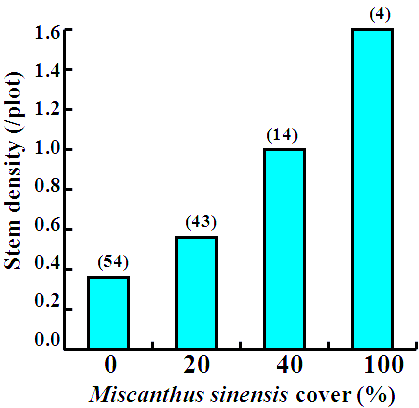(Upload on December 30 2020) [ 日本語 | English ]
Mount Usu / Sarobetsu post-mined peatland
From left: Crater basin in 1986 and 2006. Cottongrass / Daylily
[ environmental problems | landscape | references ( 参考文献 )] [ skislope glossary | restoration key ]
A snow-covered slope for skiing
How to establishProcedures on skislope establishment (in Japan)
↓ Deforestation |
By those oeprations, the gound surface does not contain any seeds and propagules. Instead of vegetation recovery by seedbanks and vegetative organs, artificial plants are dominant soon after the skislope establishment if soil erosion does not occur. • The vegetation soon after skislope establishment is perennial herbacous grassland, because of artificial seeding. • Seedbank and nutrients are poor, due to ground surface removal. |
We have to mention social and natural environmental problems.
|
Natural environmentlandscape fragmentationdecreasing water-holidng capacity decreasing water quantity and quality landslide flood soil movement (erosion) Social and living environmentcontamination from artificial snow and artificial nutrients (= fertilizer)water pollution garbage traffic noise traffic jam and others (Tsuyuzaki 1994, Tsuyuzaki 1999) |
|
Alpine skiing: skiing where boot heel is secured tightly to the skis, on developed slopes, most often using chairlifts to reach upper elevations (downhill skiing). Backcountry skiing: ski mountaineering, wherein the focus is climbing steeper slopes and mountains (typically with skis and skins) with the intent of skiing or snowboarding down challenging ungroomed and undeveloped slopes. Lift-served backcountry skiing utilizes lifts to attain much or all or the necessary elevation gain to access challenging ungroomed and undeveloped slopes. Chairlift: a series of chairs suspended from a cable driven by a motor, for conveying skiers up the slope. Classic Nordic skiing: refers to the diagonal stride technique of cross country skiing. Contrasts with skating. Glading: term for partial clearing via selective removal of trees within the boundaries of a ski run/trail. Of the total area, 40-60% of the trees would typically be removed; the remaining 40-60% of the stand would be left intact, allowing skiing between the residual trees. The ground surface would not be graded and the natural ground cover would be maintained. Grooming: to compact, spread, or otherwise prepare the snow on a ski run or slope for skiing use. Mogul: a small mound or bump of snow on a ski slope caused by the turning action of skiers. |
Nordic skiing: skiing when the boot heel is not fastened to the skis. Generally done in undeveloped areas, but may also be on trails and in tracks groomed especially for the sport. Pod: a geographic area of associated ski runs that are typically provided access via a specific ski lift. Powder skiing: skiing or boarding on fresh ungroomed snow. Run: term for a specifically prepared area cleared for skiing; synonymous with ski trail. Ski touring: skiing ungroomed trail, back country skiing, or breaking your own trail. Skiway: a run or trail that allows skiers and snowboarders to traverse the mountain and avoid additional chairlift rides. Skiways, or traverses, are also used in areas of intermediate, advanced intermediate, and expert terrain to provide an appropriate descent for guests of beginner and novice ability levels. A skiway typically has a slope gradient that averages 10%. Waterbar: an erosion control device usually constructed by digging a small ditch or piling dirt or other debris to interrupt the flow of over-the-surface water. Usually constructed on steeper ground in skid trails where the mineral soil is exposed. |
Miscanthus sinensis grassland is an indicator plant community to restore ski slope vegetation in Japan Fig. Mean number of stems established in 2 m × 2 m plot in relation to the cover of Miscanthus sinensis, investigated by octave classes. Number of plots categorized into each octave class is shown in parentheses. (Tsuyuzaki 2005)
Fig. Mean number of stems established in 2 m × 2 m plot in relation to the cover of Miscanthus sinensis, investigated by octave classes. Number of plots categorized into each octave class is shown in parentheses. (Tsuyuzaki 2005)
|
Abstract. Most ski slopes in Japan are established by forest clearcutting, scraping off the ground surface and thereby artificial seeding in well-developed forests. Recently, some ski slopes have been abandoned owing to economical failure, and more skis resorts will go bankrupt. To restore abandoned ski slopes, therefore, we have to find out appropriate indicators to restore forest cover with low cost. Vegetation data were collected in Yuzawa, central Honshu, Japan (500–760 m elevation), where ski slopes are over-concentrated. To predict the possibility of forest development, relationships between tree stem density and vegetation characteristics were examined. Trees did not establish in areas where the introduced plant cover was more than 40%. Of native grasslands, Miscanthus sinensis grassland showed the highest stem density but did not show high species richness. In particular, stem density increased with increasing M. sinensis cover. To indicate advanced successional sere towards forests, therefore, M. sinensis cover is a more appropriate indicator rather than species richness. |